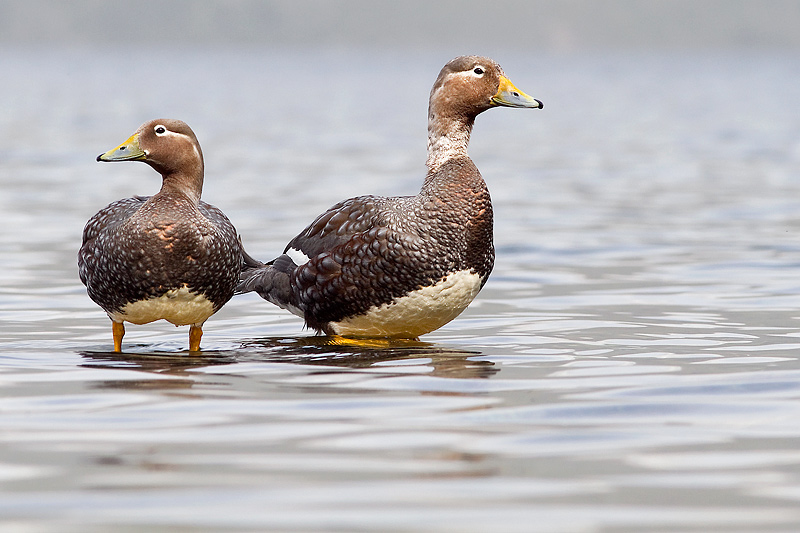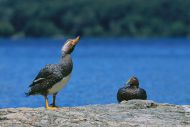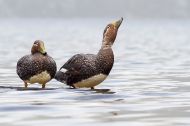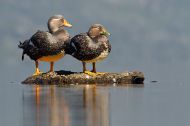Flying Steamer-Duck
Pato Vapor Volador
Tachyeres patachonicus
Length: 650mm. Sexes slightly unlike. Male: bill orange yellow with bluish patches around nostrils; iris chestnut; head ashy grey, eye-ring and postorbital band white, lores brownish grey; chin and neck ferruginous chestnut, neck pale ashy grey to whitish; breast slate-grey with wash and margin of feathers brown; flanks, upper back and scapulars slate grey with feathers margined rusty brown, giving a scaly appearance; lower back, rump and uppertail coverts uniform slate grey; rectrices blackish grey. Belly and under tail coverts yellowish white. Wing coverts slate grey; lesser underwing coverts grey; median and greater underwing coverts, axillaries and secondaries, white; primaries blackish, on bend of wing there are two bony orange yellow prominences. Legs yellow.
Female: bill greenish orange on top part and base, remainder greenish grey, nail black; iris like male; head and neck dark grey with rusty brown wash; eye-ring and postorbital band very conspicuous white; throat rusty chestnut; remainder of plumage similar to male but darker and with ferruginous brown shades. Females are slightly smaller than males, 620mm. Juveniles: immature plumage for both sexes is similar to the female but slightly drabber and darker. Habitat and behaviour: very similar to other ducks of the Tachyeres genus, the Flying Steamer-Duck is the only one overlapping with all of them. Distinguishing features to bear in mind are: the base of the bill is lower, its size is smaller than the rest, it is very good flier, the wings extend to the base of the tail. The Flying Steamer-Duck inhabits both salt waters and freshwaters of inland lakes, ponds and rivers. More often than not, it is found in pairs, but also in groups, sometimes of up to 40 or 50 individuals. It is very similar in habits to other Steamer Ducks. Roosting grounds are rocky coasts or gravel and sandy beaches. Upon danger it quickly gets into the water. If it must flee it prefers to swim or patter along the surface. Excellent diver; to become airborne it must taxi along short distances and once it takes off it flies quickly. It feeds in the water, generally diving to seize crustaceans, molluscs and snails; also dabbling and upending. The Flying Steamer-Duck nests behind the shoreline on marine coasts or freshwater lakes and ponds; sometimes the nest is built quite far from the water on the ground, concealed among grasses and brambles; the female lays and incubates up to nine creamy ivory white eggs while the male helps with caring of chicks. The term Steamer Duck given to the four species included in the Tachyeres genus comes from its habit of running across the water thrashing like a paddle-wheel steamboat. The vernacular name is Quetro or Quetru and currently this term is becoming more common than the previous Steamer Duck term. Range: distribution of the Flying Steamer-Duck or Quetro Volador goes from Neuquén and Río Negro down to Tierra del Fuego, Isla de los Estados and Islas Malvinas; in Chile it occurs from Cape Horn to Valdivia.
Illustrated Handbook of the Birds of Patagonia
Kindless: Kovacs Family
|












